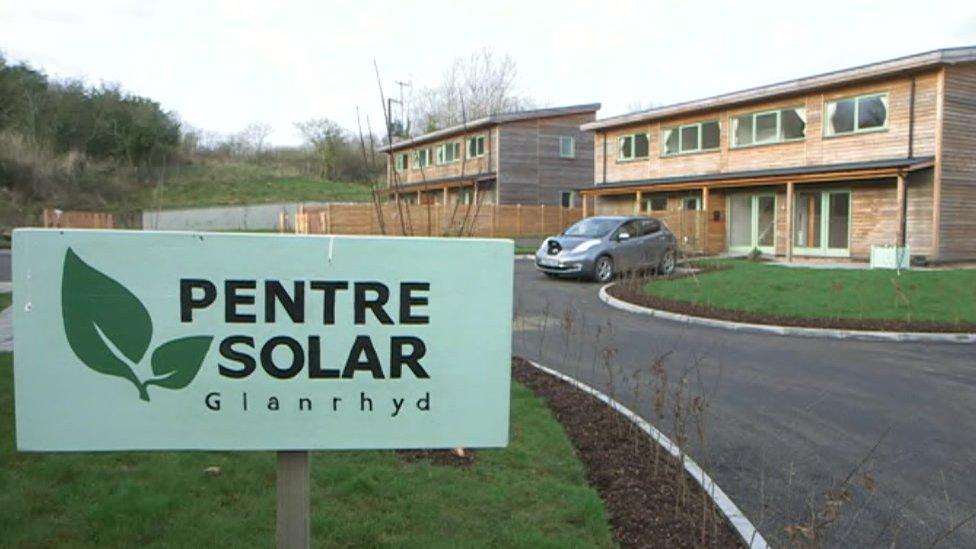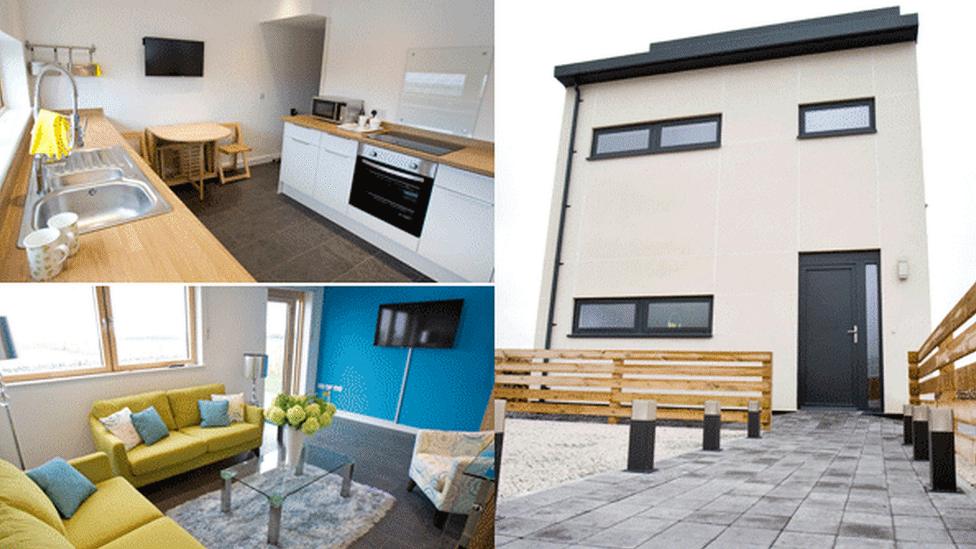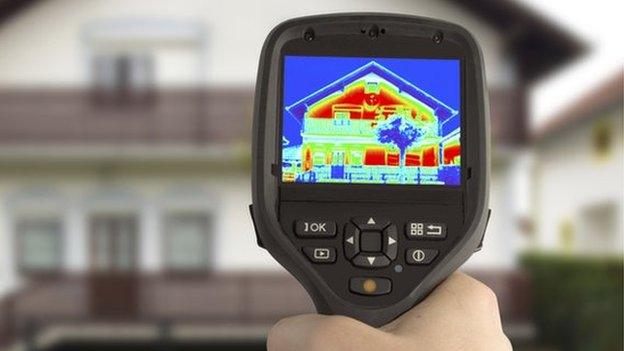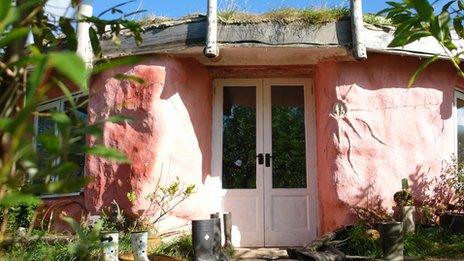Green future for Wales' homes as solar village opens?
- Published

After a new housing development which claims to be Wales' first solar village was officially opened last week, how commonplace will energy efficient homes become in the future?
Think of "eco-friendly" homes and images of green-roofed hobbit-style houses nestled in woodland might first spring to mind.
But in fact, typical "traditional" houses are becoming more green in their design and build.
At Pentre Solar, in Glanrhyd, Pembrokeshire, six timber homes face south towards the sun.
They have been built by a small start-up business, Western Solar Ltd, and use just a fraction of the energy of a traditional house.
The average two-bedroom house uses 12,500 kWh of gas and 3,100 kWh of electricity each year, costing up to £1,500.
But compare this to Pentre Solar, where residents will only have to pay £200 annually on bills.
The homes only use electricity, 4,000 kWh of it, but generate 6,000 kWh a year with any leftover electricity sold to the national grid.

Environment Secretary Lesley Griffiths cuts the ribbon to Pentre Solar with Western Solar chief executive Dr Glen Peters
They will now house people on Pembrokeshire council's waiting list and were designed to tackle the problems of energy poverty.
In Wales, a household is in fuel poverty if it spends 10% or more of its income on energy costs.
The most recent figures, external from September 2016 showed there are about 291,000 households living in fuel poverty in Wales - equivalent to 23% of households.
Dr Jo Patterson, research fellow at Cardiff University's Welsh School of Architecture, said energy efficient homes could help residents save cash.
"To be able to reduce energy bills significantly could cut the number of households in fuel poverty in Wales," she said.
"In our retrofits [refurbishing houses], we have reduced energy bills by 80%. This makes it much more affordable while also reducing carbon emissions."
Another example is the "impossible" zero-carbon house, designed by Cardiff University and supported by SPECIFIC Innovation and Knowledge Centre at Swansea University, which exports more power to the grid than it uses.
The property near Bridgend, known as Solcer House, took just 16 weeks to construct and was built in 2015.
Its technology includes insulated render on the outside, air heating systems that rely on the sun, and solar generation and battery storage used for heating and hot water.
Professor Phil Jones takes a tour of the zero-carbon house
These buildings offer a blueprint for future housing, so why are we not seeing even more developments of this kind?
Finance seems to be a key issue.
Pentre Solar has taken more than four years to finish and needed £2m of private investment.
Some government incentives have also been cut, such as subsidies for small scale solar panels on homes being reduced by 64%.
"There is very little financial incentive [for developers] at all, which is holding the market back," Dr Patterson, who was Solcer House project manager, said.
"We have had over 1,000 people visit Solcer House. We carried out analysis and out of those, 35% have been representing social housing. They are massively enthused and keen to move this forward.
"If there was funding available to make that change then progress would be significant."
However, Solcer House was built within the budget of a typical social housing cost, £1,000 per sq m, which she added showed it was possible to keep costs down.

Zero carbon house - the kitchen, exterior and living room
Much of Wales' current housing stock is also old, and while Dr Patterson estimated homeowners could retrofit the average home for about £20,000, they would need to have the money to do so.
Yet as new technology is developed, costs are coming down.
Gill Kelleher, policy and engagement manager for SPECIFIC, said it was "brilliant" that technology was "moving forward", allowing new and existing systems to be "incorporated" into homes.
To do this, issues within the supply chain need to be overcome.
"We know that we have the technology, we know that we have the skill set there to deliver these, but we need to improve some of the process of that delivery," Ms Kelleher said.
"Not only are we looking at the cost of the house, but also the cost of energy storage systems which is completely separate. At the moment it means you have to be across different cost sectors and go to different industries to get what you want."
She said there needed to be a "benchmark" so houses are built "to the optimum energy efficient standards".
Despite these barriers, it seems the benefits of energy efficient homes are striking a chord with people.
Residents won planning permission in 2009 to build nine smallholdings
The One Planet Council is an independent voluntary body which advocates One Planet Development, external, a Welsh Government policy supporting sustainable developments.
Erica Thompson, acting secretary of One Planet Council, said applications were increasing and it had seen 23 approved to date.
While the majority have been for single rural properties, she said there was "massive opportunity" for larger "edge-of-town" developments.
"It would be less about individual self-sufficiency, it would be about contributing to the nearby town," she said.
"This could be allotments, community facilities, an energy generator for the wider area; things that contribute to the economic or social sustainability of the town as well as the environmental sustainability."
'Committed'
On Monday, the Welsh Government announced it would invest an extra £40m over the next four years to improve the energy efficiency of up to 25,000 homes.
It will be targeted at low income-households or deprived communities to help people heat their homes at a more affordable cost.
It will also support other energy and carbon saving projects.
Recent changes to building regulations in Wales will also make sure all new builds are energy efficient, preventing costly upgrading in the future.
- Published16 July 2015

- Published14 July 2015

- Published23 May 2014

- Published22 January 2013
